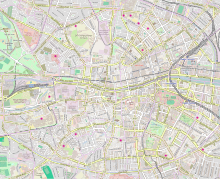South William Street, Dublin
 Clockwise from top: South William Street at its junction with Castle Market; interior of Powerscourt House; South William Street looking northeast | |
| Native name | Plás Mhic Liam Theas (Irish) |
|---|---|
| Postal code | D02 |
| Coordinates | 53°20′30″N 6°15′46″W / 53.341697°N 6.262876°W |
| Other | |
| Known for | Powerscourt House City Assembly House Rag trade |
South William Street,[1][2][3] (Irish: Plás Mhic Liam Theas) is a street located on Dublin's Southside.
Location
[edit]It runs from the junction with Exchequer Street, Wicklow Street, and St. Andrew's Street on its northeastern end to the junction of Johnson Place and Stephen Street on its southwestern end.
History
[edit]The street was laid out in 1676 by William Williams and was part of Dublin's 17th-century expansion beyond its medieval walls. The street has one of the largest and most complete groups of 18th-century merchants' houses in the city.[4][5] However, M'Cready claims the street is named after King William III.[6]
Number 12-13 on the street was built as the headquarters to the Dublin Artisans' Dwellings Company.[7]
21st century
[edit]In 2012, the street was rebranded as being the centre of Dublin's "Creative Quarter", an area noted for its "independent design stores, fashion outlets and cafes".[8] The UK's Academy of Urbanism has noted that the street has transformed "from the bustling heart of the rag trade to a well-known spot for retail entrepreneurs, start-ups and those in search of a good night out".[9]
Powerscourt House
[edit]The street is dominated by Powerscourt House, the former Dublin townhouse of Viscount Powerscourt. It was constructed in the 18th century for Richard Wingfield, 3rd Viscount Powerscourt, a member of the Irish House of Lords.[10] The townhouse was the Wingfield family's urban residence when they were visiting from the Powerscourt Estate in Enniskerry, County Wicklow.
Designed by Robert Mack, it dates from between 1771 and 1774. The court at the rear of the building was created with the addition of three brown-brick office buildings from 1809 to 1811. The townhouse was purchased and redeveloped as a shopping centre between 1978 and 1981 and is now known as the Powerscourt Townhouse Centre.[11]
Gallery
[edit]-
Metro Cafe, South William Street
-
Pink restaurant, South William Street
-
South William Street, looking southwest
See also
[edit]References
[edit]- ^ "Cafe society gives cosmopolitan image to Dublin's fastest changing street". The Irish Times. Retrieved 13 February 2022.
- ^ "People should gift cash they saved to ailing restaurants". independent. Retrieved 13 February 2022.
- ^ "The Pepper Pot Review - Dublin Ireland - Restaurant | Fodor's Travel". www.fodors.com. Retrieved 13 February 2022.
- ^ "Knocking on doors to save valuable 18th century street". The Irish Times. Retrieved 13 February 2022.
- ^ Clerkin, Paul (2001). Dublin street names. Dublin: Gill & Macmillan. pp. 190–191. ISBN 0-7171-3204-8. OCLC 48467800.
- ^ M'Cready, C. T. (1987). Dublin street names dated and explained. Blackrock, Co. Dublin: Carraig. p. 144. ISBN 1-85068-005-1. OCLC 263974843.
- ^ Fallon, Donal (2022). Three castles burning: a history of Dublin in twelve streets. Clonskeagh, Dublin, Republic of Ireland: New Island Books. p. 109. ISBN 978-1-84840-872-2. OCLC 1338685541.
- ^ Freeman, Michael. "Dublin launches new 'Creative Quarter' for city centre". TheJournal.ie. Retrieved 13 February 2022.
- ^ Admin. "South William Street | The Academy of Urbanism". Retrieved 13 February 2022.
- ^ "Powerscourt Townhouse Centre, 59 South William Street, Dublin 2, DUBLIN". Buildings of Ireland. Retrieved 13 February 2022.
- ^ Casey, Christine (2005). Dublin: the city within the Grand and Royal Canals and the Circular Road with the Phoenix Park. New Haven, Conn.; London: Yale University Press. ISBN 978-0-300-10923-8. OCLC 61702208.




